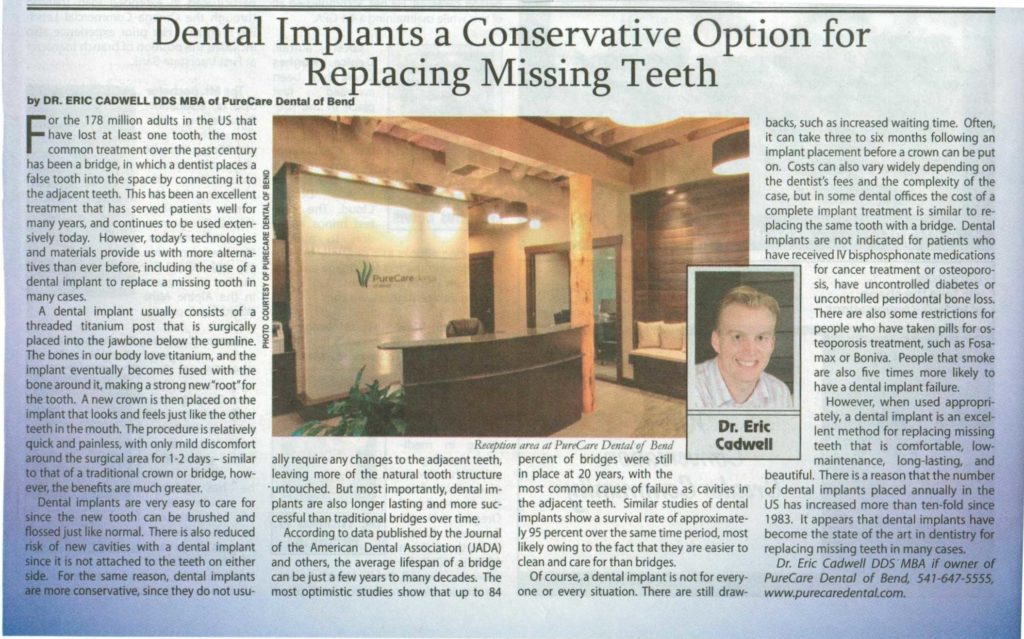Cascade Business News - Dental Implants a Conservative Option for Replacing Missing Teeth
October 5, 2011 | By Eric Cadwell DDS MBA
For the 178 million adults in the US that have lost at least one tooth, the most common treatment over the past century has been a “bridge”, in which a dentist places a false tooth into the space by connecting it to the adjacent teeth. This has been an excellent treatment that has served patients well for many years, and continues to be used extensively today. However, today’s technologies and materials provide us with more alternatives than ever before, including the use of a “dental implant” to replace a missing tooth in many cases.
A dental implant usually consists of a threaded titanium post that is surgically placed into the jawbone below the gumline. The bones in our body love titanium, and the implant eventually becomes fused with the bone around it, making a strong new “root” for the tooth. A new crown is then placed on the implant that looks and feels just like the other teeth in the mouth. The procedure is relatively quick and painless, with only mild discomfort around the surgical area for 1-2 days – similar to that of a traditional crown or bridge; however, the benefits are much greater.
Dental implants are very easy to care for, since the new tooth can be brushed and flossed just like normal. There is also reduced risk of new cavities with a dental implant, since it is not attached to the teeth on either side. For the same reason, dental implants are more conservative, since they do not usually require any changes to the adjacent teeth, leaving more of the natural tooth structure untouched. But most importantly, dental implants are also longer lasting and more successful than traditional bridges over time.
According to data published by the Journal of the American Dental Association (JADA) and others, the average lifespan of a bridge can be just a few years to many decades. The most optimistic studies show that up to 84% of bridges were still in place at 20 years, with the most common cause of failure as cavities in the adjacent teeth. Similar studies of dental implants show a survival rate of approximately 95% over the same time period, most likely owing to the fact that they are easier to clean and care for than bridges.
Of course, a dental implant is not for everyone or every situation. There are still drawbacks, such as increased waiting time. Often, it can take 3-6 months following an implant placement before a crown can be put on. Costs can also vary widely depending on the dentist’s fees and the complexity of the case, but in some dental offices the cost of a complete implant treatment is similar to replacing the same tooth with a bridge. Dental implants are not indicated for patients who have received IV bisphosphonate medications for cancer treatment or osteoporosis, have uncontrolled diabetes or uncontrolled periodontal bone loss. There are also some restrictions for people who have taken pills for osteoporosis treatment, such as Fosamax or Boniva. People that smoke are also 5 times more likely to have a dental implant failure.
However, when used appropriately, a dental implant is an excellent method for replacing missing teeth that is comfortable, low-maintenance, long-lasting, and beautiful. There is a reason that the number of dental implants placed annually in the US has increased more than 10-fold since 1983. It appears that dental implants have become the state of the art in dentistry for replacing missing teeth in many cases.

